
Nemegt Formation
Encyclopedia
The Nemegt Formation is a geological formation dating from the Late Cretaceous
sedimentary
from the Gobi Desert
of Mongolia
. It overlies and sometimes forms folds with the Barun Goyot Formation
. It consists of river channel sediments and contains fossil
s of fish
, turtle
s, crocodilians, bird
s and a diverse fauna
of dinosaur
s. The climate
associated with it was wetter than when preceding formations were deposited; there seems to have existed at least some degree of forest cover.
The absolute age of the Nemegt Formation is unknown but it is thought to be early Maastrichtian
to possibly late Campanian
in age, very roughly 70 million years old.
Cretaceous
The Cretaceous , derived from the Latin "creta" , usually abbreviated K for its German translation Kreide , is a geologic period and system from circa to million years ago. In the geologic timescale, the Cretaceous follows the Jurassic period and is followed by the Paleogene period of the...
sedimentary
Sedimentary rock
Sedimentary rock are types of rock that are formed by the deposition of material at the Earth's surface and within bodies of water. Sedimentation is the collective name for processes that cause mineral and/or organic particles to settle and accumulate or minerals to precipitate from a solution....
from the Gobi Desert
Gobi Desert
The Gobi is a large desert region in Asia. It covers parts of northern and northwestern China, and of southern Mongolia. The desert basins of the Gobi are bounded by the Altai Mountains and the grasslands and steppes of Mongolia on the north, by the Hexi Corridor and Tibetan Plateau to the...
of Mongolia
Mongolia
Mongolia is a landlocked country in East and Central Asia. It is bordered by Russia to the north and China to the south, east and west. Although Mongolia does not share a border with Kazakhstan, its western-most point is only from Kazakhstan's eastern tip. Ulan Bator, the capital and largest...
. It overlies and sometimes forms folds with the Barun Goyot Formation
Barun Goyot Formation
The Barun Goyot Formation , dating from the Late Cretaceous Period, is located within and is widely represented in the Gobi Desert basin, in the Ömnögovi Province of Mongolia....
. It consists of river channel sediments and contains fossil
Fossil
Fossils are the preserved remains or traces of animals , plants, and other organisms from the remote past...
s of fish
Fish
Fish are a paraphyletic group of organisms that consist of all gill-bearing aquatic vertebrate animals that lack limbs with digits. Included in this definition are the living hagfish, lampreys, and cartilaginous and bony fish, as well as various extinct related groups...
, turtle
Turtle
Turtles are reptiles of the order Testudines , characterised by a special bony or cartilaginous shell developed from their ribs that acts as a shield...
s, crocodilians, bird
Bird
Birds are feathered, winged, bipedal, endothermic , egg-laying, vertebrate animals. Around 10,000 living species and 188 families makes them the most speciose class of tetrapod vertebrates. They inhabit ecosystems across the globe, from the Arctic to the Antarctic. Extant birds range in size from...
s and a diverse fauna
Fauna
Fauna or faunæ is all of the animal life of any particular region or time. The corresponding term for plants is flora.Zoologists and paleontologists use fauna to refer to a typical collection of animals found in a specific time or place, e.g. the "Sonoran Desert fauna" or the "Burgess shale fauna"...
of dinosaur
Dinosaur
Dinosaurs are a diverse group of animals of the clade and superorder Dinosauria. They were the dominant terrestrial vertebrates for over 160 million years, from the late Triassic period until the end of the Cretaceous , when the Cretaceous–Paleogene extinction event led to the extinction of...
s. The climate
Climate
Climate encompasses the statistics of temperature, humidity, atmospheric pressure, wind, rainfall, atmospheric particle count and other meteorological elemental measurements in a given region over long periods...
associated with it was wetter than when preceding formations were deposited; there seems to have existed at least some degree of forest cover.
The absolute age of the Nemegt Formation is unknown but it is thought to be early Maastrichtian
Maastrichtian
The Maastrichtian is, in the ICS' geologic timescale, the latest age or upper stage of the Late Cretaceous epoch or Upper Cretaceous series, the Cretaceous period or system, and of the Mesozoic era or erathem. It spanned from 70.6 ± 0.6 Ma to 65.5 ± 0.3 Ma...
to possibly late Campanian
Campanian
The Campanian is, in the ICS' geologic timescale, the fifth of six ages of the Late Cretaceous epoch . The Campanian spans the time from 83.5 ± 0.7 Ma to 70.6 ± 0.6 Ma ...
in age, very roughly 70 million years old.
Oviraptorosaurs
| Oviraptorosaurs reported from the Nemegt Formation | ||||||
|---|---|---|---|---|---|---|
| Genus | Species | Location | Stratigraphic Position | Material | Notes | Images |
Avimimus Avimimus Avimimus , meaning "bird mimic" , was a genus of bird-like maniraptoran dinosaur that lived in the late Cretaceous in what is now Mongolia, around 70 million years ago.-Description:... |
Avimimus portentosus |
Avimimids. | 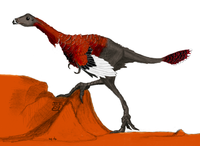 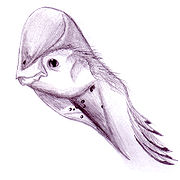 |
|||
Indeterminate |
Avimimids. | |||||
Elmisaurus Elmisaurus Elmisaurus is an extinct genus of dinosaur from the Late Cretaceous. It was a theropod belonging to the Oviraptorosauria. Its fossils have been found in Asia and North America. It is known from only its feet and hands.... |
Elmisaurus rarus |
"[Three] pedes [and a] manus." |
A caenagnathid. | |||
Conchoraptor Conchoraptor Conchoraptor is a genus of oviraptorid dinosaur from the late Cretaceous Period of what is now Asia.-Description:... |
C. gracilis |
|
|
"Partial skeleton wwith skull, [four] partial skulls, [and] numerous skull and postcranial fragments." |
||
"Ingenia Ingenia "Ingenia" is a genus of oviraptorid theropod dinosaurs, with one known species, "Ingenia" yanshini. Fossils have been found in several Late Cretaceous-age formations of Mongolia, most prominently in the Bugin Tsav beds of the Nemegt Formation, which has also yielded the holotype of Mononykus... " |
"Ingenia" yanshini |
|
|
"Partial skeleton with skull [and five] partial postcrania." |
An oviraptorid, also found in the Barun Goyot Formation Barun Goyot Formation The Barun Goyot Formation , dating from the Late Cretaceous Period, is located within and is widely represented in the Gobi Desert basin, in the Ömnögovi Province of Mongolia.... . |
|
Nemegtomaia Nemegtomaia Nemegtomaia is a genus of oviraptorid dinosaur from the late Cretaceous Period of what is now Mongolia. The type species, Nemegtomaia barsboldi, was described by Lü, Tomida, Azuma, Dong, and Lee in 2004... |
Nemegtomaia barsboldi |
An oviraptorid. | ||||
Nomingia Nomingia Nomingia is a genus of oviraptorid theropod dinosaur hailing from the Late Cretaceous Bugin Tsav Beds of Mongolia.-Discovery and naming:... |
N. gobiensis |
"Partial postcranium." |
||||
Rinchenia Rinchenia Rinchenia is a genus of Mongolian oviraptorid dinosaur from the late Cretaceous Period. The type species, Rinchenia mongoliensis, was originally classified as a species within the genus Oviraptor , but a re-examination by Barsbold in 1997 found differences significant enough to warrant a separate... |
Rinchenia mongoliensis |
"Skull and fragmentary postcranium." |
An oviraptorid. |
|||
Paravians
| Paravians reported from the Nemegt Formation | ||||||
|---|---|---|---|---|---|---|
| Genus | Species | Location | Stratigraphic Position | Material | Notes | Images |
Adasaurus Adasaurus Adasaurus is a genus of dromaeosaurid theropod dinosaur from the Late Cretaceous Period of what is now Central Asia. It was a small bipedal carnivore with a sickle-shaped claw on the second toe of each hind foot. An adult was perhaps about long.... |
Adasaurus mongoliensis |
"Partial skull and fragmentary postcrania." |
A dromaeosaurid. |
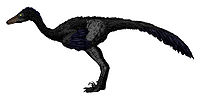 |
||
Borogovia Borogovia Borogovia was a theropod dinosaur genus which lived during the Late Cretaceous Period, in what is now Mongolia. The agile carnivorous troodontid takes its name from creatures known as 'borogoves' in the Lewis Carroll poem, Jabberwocky.... |
Borogovia gracilicrus |
"Partial hindlimbs." |
A troodontid. | |||
Gurilynia Gurilynia Gurilynia was a Genus of enantiornithine birds. One species is known, G. nessovi. It lived during the Maastrichtian stage of the Late Cretaceous period, between 70 and 65 mya. Gurilynia is known from fragmentary fossils found at the Gurilyn Tsav locality of the Nemegt Formation in south Gobi,... |
Gurilynia nessovi |
"Shoulder girdle and forelimb elements." |
An enantiornithine. | |||
Judinornis Judinornis Judinornis is a prehistoric flightless bird genus from the Late Cretaceous. The single known species is Judinornis nogontsavensis... |
Judinornis nogontsavensis |
"Vertebra." |
A hesperornithine Hesperornithes Hesperornithes is an extinct and highly specialized clade of Cretaceous toothed birds. Hesperornithine birds, apparently limited to former aquatic habitats in the Northern Hemisphere, include genera such as Hesperornis, Parahesperornis, Baptornis, Enaliornis, and probably Potamornis, all... . |
|||
Saurornithoides Saurornithoides Saurornithoides is a genus of troodontid maniraptoran dinosaur, living during the Late Cretaceous period. These creatures were predators, which could run fast on their hind legs and had excellent sight and hearing... |
S. junior |
Reclassified as Zanabazar junior |
||||
Teviornis Teviornis Teviornis is a genus of extinct birds. One species has been described, T. gobiensis. It lived in the Maastrichtian stage at the end of the Late Cretaceous period, some 70 million years ago. It is known from fossils collected from the Nemegt Formation of Gobi, south Mongolia.The fossils include only... |
Teviornis gobiensis |
An anseriform related to modern ducks and geese. | ||||
Tochisaurus Tochisaurus Tochisaurus is a genus of small theropod dinosaur. It lived during the Late Cretaceous Period. Its fossils, consisting solely of the metatarsus, were found in Mongolia. The type species is T. nemegtensis, formalized by Kurzanov and Osmólska in 1991... |
Tochisaurus nemegtensis |
A metatarsus. |
A troodontid. | |||
Zanabazar Zanabazar (dinosaur) Zanabazar is a genus of troodontid dinosaur, which lived during the Late Cretaceous period in Mongolia.Fossils of this theropod have been found in the Nemegt Formation of Mongolia. Originally classified as a new species of the genus Saurornithoides by Rinchen Barsbold in 1974, based on a small... |
Zanabazar junior |
"Skull with fragmentary postcranial skeleton." |
A troodontid. |
|||
Other coelurosaurs
| Misc Coelurosaurs reported from the Nemegt Formation | ||||||
|---|---|---|---|---|---|---|
| Genus | Species | Location | Stratigraphic Position | Material | Notes | Images |
Alioramus Alioramus Alioramus is a genus of tyrannosaurid theropod dinosaur from the Late Cretaceous period of Asia. The type A. remotus, is known from a partial skull and three metatarsals recovered from Mongolian sediments which were deposited in a humid floodplain between 70 and 65 million years ago. These... |
Alioramus remotus |
A tyrannosaur Tyrannosauridae Tyrannosauridae is a family of coelurosaurian theropod dinosaurs which comprises two subfamilies containing up to six genera, including the eponymous Tyrannosaurus. The exact number of genera is controversial, with some experts recognizing as few as three... , actually present in the Beds of Nogoon Tsav Beds of Nogoon Tsav The Beds of Nogoon Tsav is a geological formation in Mongolia whose strata date back to the Late Cretaceous. Dinosaur remains are among the fossils that have been recovered from the formation.-References:... . Nemegt fossils reclassified as A. altai. |
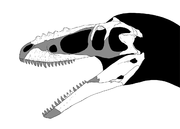 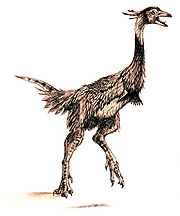 |
|||
Alioramus altai |
A tyrannosaur Tyrannosauridae Tyrannosauridae is a family of coelurosaurian theropod dinosaurs which comprises two subfamilies containing up to six genera, including the eponymous Tyrannosaurus. The exact number of genera is controversial, with some experts recognizing as few as three... . |
|||||
Anserimimus Anserimimus Anserimimus is a genus of ornithomimid theropod dinosaur, from the Late Cretaceous Period of what is now Mongolia. It was a lanky, fast-running animal, possibly an omnivore... |
Anserimimus planinychus |
"Incomplete postcranium." |
An ornithomimid. | |||
Bagaraatan Bagaraatan Bagaraatan was a genus of theropod dinosaur from the Late Cretaceous period. Its fossils were found in the Nemegt Formation of Mongolia. Bagaraatan may have been around 3–4 metres in length.... |
Bagaraatan ostromi |
"Fragmentary skull and associated postcranium." |
A coelurosaur or uncertain classification. | |||
Deinocheirus Deinocheirus Deinocheirus is a genus of large theropod dinosaur, possibly an ornithomimosaurian, which lived in what is now southern Mongolia, during the late Cretaceous Period .-Discovery and naming:... |
Deinocheirus mirificus |
"Forelimb elements." |
A giant ornithomimosaur. | |||
Gallimimus Gallimimus Gallimimus is a genus of ornithomimid theropod dinosaur from the late Cretaceous period Nemegt Formation of Mongolia. With individuals as long as , it was one of the largest ornithomimosaurs... |
Gallimimus bullatus |
"[Three] nearly complete skeletons, complete postcranium, skull with associated frgamentary postcranium, [and] other fragmentary postcrania." |
An ornithomimid. | |||
Mononykus Mononykus Mononykus was a theropod dinosaur from late Cretaceous Mongolia with long, skinny legs. It moved about on two legs, was very nimble, and could run at high speeds, something that would have been useful in the open desert plains where it lived... |
Mononykus olecranus |
An alvarezsaurid. | ||||
Tarbosaurus Tarbosaurus Tarbosaurus is a genus of tyrannosaurid theropod dinosaur that flourished in Asia about 70 million years ago, at the end of the Late Cretaceous Period. Fossils have been recovered in Mongolia, with more fragmentary remains found further afield in parts of China. Although many species have been... |
Tarbosaurus bataar |
A tyrannosaur. Articulated skeletons are unusually common here. May also be present in the Djadochta Formation Djadochta Formation The Djadochta Formation is situated in central Asia and dates from the Late Cretaceous Period. Laid down in the early Campanian, possibly starting in the latest Santonian, it is dated somewhat uncertainly at about 84-75 mya... . |
||||
Therizinosaurus Therizinosaurus Therizinosaurus is a genus of very large theropod dinosaur. Therizinosaurus lived in the late Cretaceous Period , and was one of the last and largest representatives of its unique group, the Therizinosauria... |
Therizinosaurus cheloniformis |
|
|
"Forelimb elements [and a] referred hindlimb." |
A therizinosaur Therizinosaur Therizinosaurs are theropod dinosaurs belonging to the clade Therizinosauria. Therizinosaur fossils have been found in Early through Late Cretaceous deposits in Mongolia, the People's Republic of China and Western North America... . |
|
Invertebrates
| Invertebrate Invertebrate An invertebrate is an animal without a backbone. The group includes 97% of all animal species – all animals except those in the chordate subphylum Vertebrata .Invertebrates form a paraphyletic group... s of the Nemegt Formation |
||||||
|---|---|---|---|---|---|---|
| Genus | Species | Location | Stratigraphic Position | Abundance | Notes | |
Nemegtia |
An ostracod Ostracod Ostracoda is a class of the Crustacea, sometimes known as the seed shrimp because of their appearance. Some 65,000 species have been identified, grouped into several orders.... . |
|||||
Mammals
| Mammal Mammal Mammals are members of a class of air-breathing vertebrate animals characterised by the possession of endothermy, hair, three middle ear bones, and mammary glands functional in mothers with young... s of the Nemegt Formation |
||||||
|---|---|---|---|---|---|---|
| Genus | Species | Location | Stratigraphic Position | Abundance | Notes | Images |
Buginbaatar Buginbaatar Buginbaatar is an extinct genus of mammal from the Upper Cretaceous of Mongolia. It is a member of the extinct order Multituberculata, within the suborder Cimolodonta and family Cimolomyidae. It lived towards the end of the Mesozoic era.... |
Buginbaatar transaltaiensis |
A multituberculate. |
||||
Ornithischians
| Ornithischians of the Nemegt Formation | ||||||
|---|---|---|---|---|---|---|
| Genus | Species | Location | Stratigraphic Position | Material | Notes | Images |
Barsboldia Barsboldia Barsboldia was a genus of large hadrosaurid dinosaur from the early Maastrichtian Nemegt Formation of Ömnogöv', Mongolia. It is known from a partial vertebral column, partial pelvis, and some ribs... |
Barsboldia sicinskii |
"Sacrum [and] pelvis." |
A hadrosaurid Hadrosaurid Hadrosaurids or duck-billed dinosaurs are members of the family Hadrosauridae, and include ornithopods such as Edmontosaurus and Parasaurolophus. They were common herbivores in the Upper Cretaceous Period of what are now Asia, Europe and North America. They are descendants of the Upper... . |
 |
||
Homalocephale Homalocephale Homalocephale is a genus of dinosaur belonging to the pachycephalosaurid family, which lived during the late Cretaceous period of what is now Mongolia, 80 million years ago. The genus was described in 1974 by Osmólska & Maryañska, and consists of a single species, H... |
Homalocephale calathoceros |
A pachycephalosaur. | ||||
Prenocephale Prenocephale Prenocephale was a small pachycephalosaurid dinosaur genus from the Late Cretaceous and was similar in many ways to its close relative, Homalocephale, which may simply represent Prenocephale juveniles. Adult Prenocephale probably weighed around and measured around long... |
P. prenes |
"Complete skull with associated partial postcranium." |
||||
Saurolophus Saurolophus Saurolophus is a genus of large hadrosaurine duckbill that lived about 69.5-68.5 million years ago, in the Late Cretaceous of North America and Asia; it is one of the few genera of dinosaurs known from multiple continents. It is distinguished by a spike-like crest which projects up and back... |
Saurolophus angustirostris |
"At least [fifteen] specimens, including articulated skull and postcranial skeleton." |
A hadrosaurid. | |||
Tarchia Tarchia Tarchia is a genus of ankylosaurid dinosaur from the late Cretaceous of Mongolia. It is currently the geologically youngest known of all the Asian ankylosaurid dinosaurs and is represented by five or more specimens, including two complete skulls and one nearly complete postcranial skeleton... |
Tarchia gigantea |
An ankylosaur, also found in the Barun Goyot Formation Barun Goyot Formation The Barun Goyot Formation , dating from the Late Cretaceous Period, is located within and is widely represented in the Gobi Desert basin, in the Ömnögovi Province of Mongolia.... . |
||||
Sauropods
| Sauropods reported from the Nemegt Formation | ||||||
|---|---|---|---|---|---|---|
| Genus | Species | Location | Stratigraphic Position | Material | Notes | Images |
Nemegtosaurus Nemegtosaurus Nemegtosaurus was a sauropod dinosaur from Late Cretaceous Period of what is now Mongolia. It was named after the Nemegt Basin in the Gobi Desert, where the remains — a single skull — were found... |
Nemegtosaurus mongoliensis |
"Skull." |
A titanosaur Titanosaur Titanosaurs were a diverse group of sauropod dinosaurs, which included Saltasaurus and Isisaurus. It includes some of the heaviest creatures ever to walk the earth, such as Argentinosaurus and Paralititan — which some believe have weighed up to 100 tonnes... . |
 |
||
Opisthocoelicaudia Opisthocoelicaudia Opisthocoelicaudia was 12-metre-long sauropod dinosaur of the Late Cretaceous Period discovered in Mongolia in 1965 by Polish and Mongolian scientists in what is now the Gobi Desert... |
Opisthocoelicaudia skarzynskii |
"Skeleton lacking skull and cervical series." |
A titanosaur. |
|||
See also
- Barun Goyot FormationBarun Goyot FormationThe Barun Goyot Formation , dating from the Late Cretaceous Period, is located within and is widely represented in the Gobi Desert basin, in the Ömnögovi Province of Mongolia....
- Djadochta FormationDjadochta FormationThe Djadochta Formation is situated in central Asia and dates from the Late Cretaceous Period. Laid down in the early Campanian, possibly starting in the latest Santonian, it is dated somewhat uncertainly at about 84-75 mya...
- List of fossil sites
- Nemegt BasinNemegt BasinThe Nemegt Basin is situated in the northwestern part of the Gobi Desert, in the Ömnögovi Province in the southern part of Mongolia. It is known locally as the valley of the dragons, since it is a source of many fossil finds, including dinosaurs, dinosaur eggs and trace fossils.The main geological...
- List of dinosaur-bearing rock formations

